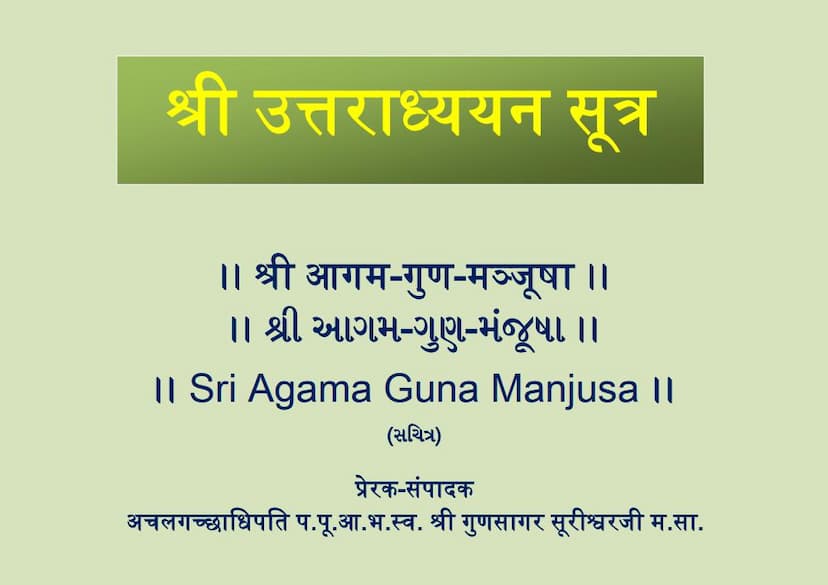Agam 43 Mool 04 Uttaradhyayan Sutra Shwetambar Agam Guna Manjusha
Added to library: September 1, 2025

Summary
This document is an excerpt from Agam 43 Mool 04 Uttaradhyayan Sutra Shwetambar Agam Guna Manjusha, authored by Gunsagarsuri and published by Jina Goyam Guna Sarvoday Trust Mumbai. The provided text offers a comprehensive overview of the 45 Jain Agamas, categorizing them into several groups:
I. Eleven Angas (Main scriptures)
The text briefly describes each of the eleven Angas, highlighting their primary themes, number of lessons (adhyayana), approximate number of verses (sloka), and key philosophical concepts.
- Achāranga-sutra: Focuses on the virtuous conduct of monks and householders, with 25 lessons.
- Sūtracritanga-sutra: Discusses various philosophical schools (180 ritualists, 84 non-ritualists, 67 agnostics), with 23 lessons.
- Sthānanga-sutra: Deals with calculation and enumeration of objects from one to ten, with a unique style.
- Samavāyanga-sutra: Similar to Sthānanga-sutra, it lists objects from one to crores and beyond.
- Vyākhyāprajñapti-sutra (Bhagavati-sutra): The largest Agama, featuring the questions of Gautama Ganadhara and answers of Lord Mahavira across 42 centuries and 1925 topics. It's described as a treasure of gems.
- Jñātā-dharma-kathānga-sutra: Relates religious discourses and stories, with 19 available narratives.
- Upāsaka-dasānga-sutra: Describes the 12 vows and the life stories of 10 great lay followers, blending religious discourse and conduct.
- Antakr̥d-daśānga-sutra: Primarily focuses on religious discourse, detailing the lives of souls who attained liberation through penance.
- Anuttaraupapātika-daśānga-sūtra: Narrates the lives of great lay followers who attained heavenly states and later achieved liberation.
- Praśna-vyākaraṇa-sūtra: Deals with the ways of conduct, presenting Lord Mahavira's answers to various questions and discussing transgression and self-control.
- Vipāka-sūtrānga-sūtra: Divided into two parts: "Fruition of Misery" (10 sinful souls) and "Fruition of Happiness" (10 virtuous souls).
II. Twelve Upangas (Subsidiary scriptures)
The text then outlines the 12 Upangas, explaining their connection to the Angas and their content:
- Aupapātika-sūtra: Subservient to Achāranga-sutra, describing Campā city, 12 types of austerity, etc.
- Rājapraśnīya-sūtra: Subservient to Sūtracritanga-sutra, depicting King Pradesi's reign and the worship of Jina idols.
- Jivābhigama-sūtra: Subservient to Sthānanga-sutra, analyzing self and non-self, and detailing rituals.
- Prajñāpanā-sūtra: Subservient to Samavāyanga-sutra, describing 36 topics.
- Sūrya-prajñapti-sūtra & Candra-prajñapti-sūtra: Both are primarily focused on calculation, detailing celestial movements and phenomena.
- Jambūdvīpa-prajñapti-sūtra: Also focused on calculation, it describes the Jambū continent in detail.
- Nirayāvali-sūtra: Part of the "Nirayāvali-pañcaka," it recounts the war and the fate of King Śreṇika's sons.
- Kalpāvatamsaka-sūtra: Describes the life stories of princes like Kāla-kumāra and Padmakumāra.
- Puṣpiyā-upāṅga-sūtra: Contains 10 lessons covering various deities and lay followers.
- Puṣpacūlikā-upāṅga-sūtra: Details the previous births of 10 goddesses.
- Vṛṣṇidaśā-upāṅga-sūtra: Features stories of the Vṛṣṇi dynasty and their prominent figures.
- The last five Upangas are collectively called the "Nirayāvali-pañcaka."
III. Ten Payanna-sutras (Supplementary scriptures)
The text then lists the 10 Payanna-sutras, focusing on various aspects of religious practice and knowledge:
- Āturapratyākhyāna-sūtra: Deals with final religious practices and death-related contemplation.
- Bhakṣaparijñā-sūtra: Discusses types of death and spiritual attainment.
- Sansthāraka-payaṇṇā-sūtra: Extols the practice of Sansthāraka (fasting unto death).
- Tandula-vicāra-payaṇṇā-sūtra: Discusses the amount of food consumed by a soul over 100 years, emphasizing spiritual life.
- Candāvijaya-payaṇṇā-sūtra: Focuses on religious practices that improve one's death.
- Devendra-stuti-payaṇṇā-sūtra: Presents hymns sung by Indra and related details.
- Māraṇasamādhi-payaṇṇā-sūtra: Details final religious practices and summaries of chapters on death.
- Mahāpratyākhyāna-payaṇṇā-sūtra: Elaborates on practices for monks at the time of death.
- Gaṇividyā-payaṇṇā-sūtra: Summarizes major works on astrology.
- The text also mentions that these 10 Payanna-sutras have about 2500 verses in total and notes that sometimes Gacchācāra is considered instead of Candāvijaya.
IV. Six Cheda-sutras (Texts on discipline and expulsion)
These scriptures are presented as highly rigorous and are meant for advanced monks:
- Vyavahāra-sūtra
- Niśītha-sūtra
- Mahāniśītha-sūtra
- Pañcakalpa-sūtra
- Daśāśruta-skandha-sūtra
- Bhaṭakalpa-sūtra (note: the original text has a slight discrepancy here, listing it as 'Bhatkalpa' in the English introduction but 'Jeetkalpa' in the Gujarati text. The commonly accepted list includes Jītakalpa.)
These Chedasutras deal with rules, exceptions, and penance, and their study is restricted to highly qualified monks.
V. Four Mūla-sutras (Root scriptures)
These are considered fundamental texts for understanding Jain principles:
- Daśavaikālika-sūtra: Described as a lake of nectar for monks and nuns in the current era, it contains 10 lessons and two concluding sections (Colikas).
- Uttarādhyayana-sūtra: Contains the final sermons of Lord Mahavira, detailing detachment and the conduct of monks in 36 lessons.
- Anuyogadvāra-sūtra: Considered the "key to all Agamas," it explains the structure of scriptures and the path of devotion through four modes of analysis.
- Āvaśyaka-sūtra: Essential for all four categories of Jain followers, it outlines six obligatory daily duties (Samayika, Caturviṁśatistava, Vandana, Pratikramaṇa, Kāyotsarga, Paccakhāṇa).
VI. Two Chūlikās (Appendices)
These are supplementary texts:
- Nandi-sūtra: Contains hymns to Lord Mahavira, similes for the Jain community, lists of Tirthankaras and Ganadharas, and details on the fivefold knowledge.
- Anuyogadvāra-sūtra: (This is mentioned again as a Chūlikā in some classifications, though it's also a Mūla-sūtra. The text clarifies its role as the key to understanding other Agamas.)
Overall Purpose:
The document, "Agam 43 Mool 04 Uttaradhyayan Sutra Shwetambar Agam Guna Manjusha," serves as a guide to the vast Jain scripture collection. It aims to provide a concise understanding of the 45 Agamas, their contents, and their significance within the Jain tradition. The text emphasizes the importance of these scriptures for spiritual practice and liberation. The latter part of the document provides the actual text of several chapters from the Uttaradhyayana Sutra, detailing various ethical principles and conduct for monks.